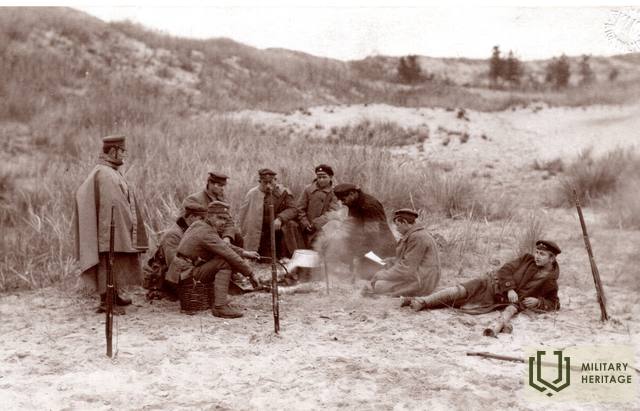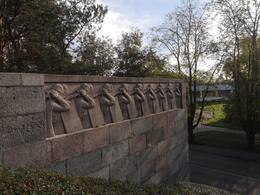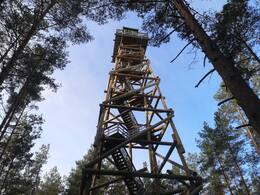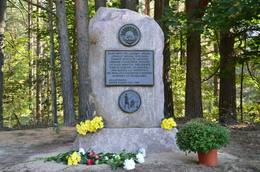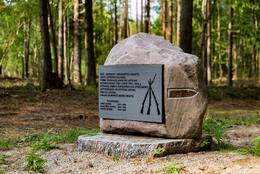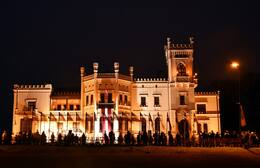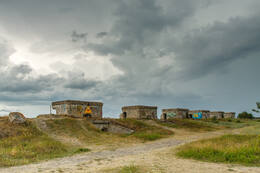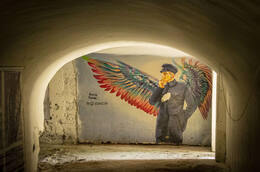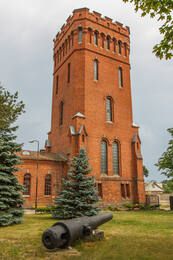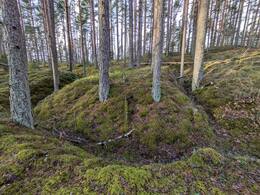Bermontiada I Nepriklausomybės karai

Bermonto kampanija yra Latvijos Nepriklausomybės karo dalis, kurioje Latvijos armija, remiama Antantės sąjungininkų, kovojo nuo 1919 m. spalio 8 d. iki 1919 m. gruodžio 3 d. Ji prasidėjo Bermonto armijos puolimu prieš Rygą ir baigėsi jos pralaimėjimu bei išvarymu iš Latvijos. Pavelo Bermonto vadovaujamos pajėgos buvo geriau aprūpintos ir skaičiumi pranoktos, tačiau naujai įkurtos Latvijos armijos kariai atsakė kovinga dvasia ir patriotizmu.
Lemiamas lūžio taškas įvyko 1919 m. lapkričio 10 ir 11 d., kai Latvijos armija išlaisvino Pardaugavą iš bermontininkų, o Bermonto armijos (Vakarų Rusijos savanorių armijos) kariai atsitraukė į Jelgavą, kurios išlaisvinimas lapkričio 21 d. faktiškai žymėjo bermontiadų pabaigą. Iki visiško Latvijos teritorijos išlaisvinimo dar reikėjo kovoti sunkius mūšius, tačiau bermontiados buvo vienas reikšmingiausių lūžio taškų Latvijos Nepriklausomybės kare.
Tai buvo vienas kruviniausių Latvijos Nepriklausomybės karo (1918–1920 m.) puslapių ir kartu naujai susikūrusios Latvijos valstybės žmonių nacionalinės valios liudijimas, pirmoji didelė Latvijos armijos, kaip vieno nepriklausomo vieneto, pergalė. Bermonto karas Latvijos istorijoje turi ne tik karinę reikšmę, bet ir reikšmę, patvirtinančią Latvijos žmonių didvyriškumą. Įnirtingi mūšiai įrodė, kad Latvijos žmonės geba kovoti už savo ateitį. Dauguma buvo vieningi kovoje ne tik už nepriklausomybę, bet ir už demokratijos, socialinio ir nacionalinio teisingumo idealus. Latvijai ši pergalė reiškė galutinį išsivadavimą iš Vokietijos ginkluotųjų pajėgų, taip pat galimybę sutelkti dėmesį į Latgalos išvadavimą iš Sovietų Rusijos valdžios.
Pavelas Bermontas-Avalovas (1877–1973) buvo visko, prieš ką šioje kovoje stojo naujosios Latvijos valstybės kūrėjai, simbolis. Savarankiškai pasiskelbęs pulkininkas puoselėjo viltis atkurti buvusią Rusijos imperiją, niekindamas mažų valstybių teisę į nepriklausomybę. Žlugusios imperijos atgaivinimo kelyje naujoji Latvijos valstybė Bermontams teikė lygiai tokį patį priešą kaip ir bolševikai Maskvoje.
Minint Pārdaugavos išvadavimą iš bermontininkų, lapkričio 11-oji dabar švenčiama kaip Lačplėsio diena, pagerbiant Latvijos karius.
Daugiau informacijos šaltinių
Celvezi.lv. 2020. Bermontiada – Latvijos laisvės kovos epizodas. Prieinama: https://www.celvezi.lv/raksti/vesture/bermontiade/ [žiūrėta 2021-05-06].
Susijusios vietos
Sudrabkalninio kalnas – memorialas kovai su Bermonto armija
Įsikūręs Rygoje, Pārdaugavoje, Sloko ir Kurzemes prospektų sankirtoje.
1919 m. lapkričio pradžioje, per Latvijos nepriklausomybės karus, Pardaugavoje vyko gatvių mūšiai tarp Latvijos armijos ir Bermonto kariuomenės. Lemiamas puolimas prieš Bermonto armiją įvyko šioje vietovėje. 1937 m. Sudrabkalninyje pagal Kārlio Zālės projektą buvo atidengtas paminklas, pagerbiantis žuvusius 6-ojo Rygos pėstininkų pulko karius ir pabrėžiantis jų karines savybes.
Sukurta kaip memorialinė siena – simbolinis įtvirtinimas, kurio vartuose pavaizduotas liūtas, blokuojantis kelią priešo puolimui. Pastatyta iš Daugavgryvos tvirtovės gynybinio pylimo akmeninių blokų ir iškalta iš Laisvės paminklo likusio granito. Memorialinės vietos kaina siekė beveik 35 000 latų. Palyginimui, už šią sumą buvo galima įsigyti 4 Latvijoje pagamintus „Ford - Shield V8 De Luxe“ automobilius.
Šiandien galite aplankyti vieną įspūdingiausių Nepriklausomybės kovų memorialų.
Bumbu kalvos gaisrų stebėjimo bokštas
Latvijos laisvės kovų atminimo vieta. 1919 m. lapkritį, per Bermontiadas, čia buvo įsikūręs Krišjanio Berkio vadovaujamos Latgalos divizijos vadovavimo postas. 6-asis Rygos pėstininkų pulkas, puldamas nuo Bumbu kalno, užėmė Sudrabkalninį.
Latvijos Nepriklausomybės karo įvykių atminimo vieta Marupėje
Įsikūręs Marupės savivaldybėje, kelio tarp golfo klubo „Viesturi“ ir Božių rezervuaro pusėje.
Memorialas atidengtas 2013 m. Vietovės istorija susijusi su Latvijos armijos mūšiu prieš Bermonto kariuomenę 1919 m. Netoli Adienių namo kovos pozicijose buvo dislokuoti Latvijos armijos daliniai.
Nepriklausomybės karo metu dėl sunkios padėties Latvijos vyriausybė neturėjo galimybių aprūpinti kariuomenės tuo, ko jai reikėjo. Kareivių išvaizda ir ginkluotė skyrėsi. Dažniausiai aprūpinimas buvo grindžiamas karių gebėjimu apsirūpinti patiems. 1919 m. rugsėjo pabaigoje ir spalio pradžioje iš Didžiosios Britanijos atvyko Latvijos karinis užsakymas trūkumui pašalinti. Po mėnesio buvo gautas ir angliškos ginkluotės siuntinys. Gavus pirmuosius krovinius, buvo aišku, kad Didžioji Britanija atsikratė nereikalingų atsargų. Taip pat buvo gaunami nešvarūs, susidėvėję drabužiai ir batai, kurie dažnai būdavo per maži. Kai kareiviai avėdavo netinkamą batą, kildavo sveikatos problemų, kurios paveikė jų kovines galimybes. Drabužiai buvo taisomi ir siuvami. Pagrindinis vienijantis simbolis buvo 11 spindulių saulės ženklas ant kepurės ir raudonai baltas tvarstis aplink kairę ranką.
Šiandien čia galima aplankyti keletą memorialinių vietų. Jos yra vaizdingo, specialiai sukurto istorinio ir gamtos žygių maršruto dalis.
Gidas Miķelis Jakunovas, +371 28353679.
Antrasis paminklas pirmosios nepriklausomos Latvijos kariams Marupėje
Įsikūręs Marupės savivaldybėje, priešais golfo klubo „Viesturi“ pastatą, miško kelyje, priešais nuorodą į golfo aikštyną.
Projekto idėjos autoriai – Mārupės krašto gidas Miķelis Jakunovas ir žemės sklypo „Dumpmaļi“ savininkas Visvaldis Dumpis.
2014 m. lapkritį, per Latvijos patriotų savaitę, skirtą pagerbti Latvijos karius, miške netoli Dzilnupytės, Marupe ir Babytės apskričių pasienyje, dar viename Pirmojo pasaulinio karo mūšio lauke, buvo atidengtas antrasis paminklas Latvijos kariams. Paminklo idėjos autorius ir finansuotojas yra Visvaldis Dumpis, o jį sukūrė skulptorius Ivaras Feldbergsas. Atminimo vietos savininkas Visvaldis Dumpis norėtų, kad žmonės čia rinktųsi ne tik birželio 14 ir kovo 25 dienomis, bet ir liepos 10 d., minint krašto apsaugos pajėgų įkūrimo metines, bei kitais latviams svarbiais istoriniais įvykiais.
2018 m. lapkričio 9 d. prie paminklo atidarytas informacinis stendas apie vietovės istoriją ir lankytinus objektus. Jis skirtas vietovės istorijai, pasakojant apie kadaise buvusius namus „Adieņi“ ir juose gyvenusią Ķurbjų šeimą, Pirmojo pasaulinio karo įvykius apylinkėse, taip pat apie istorinius objektus, kurių gamtoje nebeįmanoma pamatyti – Dūčių tiltą, Dzirnavų tvenkinį ir malūną bei Medžioklės pirtį.
Generolo Pēterio Radziņa memorialinė vieta
Įsikūręs Valkos valsčiuje, važiuojant keliu Valka–Rūjiena (P22) 4 kilometre, pasukite į dešinę, sekant nuorodas.
Pēteris Radziņš gimė 1880 m. gegužės 2 d. Lugažių parapijos „Jaunvīndedzēs“. Mokėsi Lugažių parapijos mokykloje, Valkos miesto mokykloje ir Valkos Nelsono realinėje mokykloje. Savanoriu įstojo į Rusijos armiją. 1919 m. rudenį grįžo į Latviją ir spalio 27 d. buvo paskirtas Vyriausiojo armijos vado štabo viršininku, šias pareigas užimdamas tuo metu, kai bermontininkai kėlė grėsmę Rygai. Būdamas štabo viršininku, jis vadovavo visiems mūšiams Rygoje, Žiemgaloje ir Latgaloje. 1920 m. vasario 5 d. buvo paaukštintas generolu.
Šiandien šalia šeimos namų galima pamatyti generolui Pēteriui Radzinšui (1880–1930) skirtą atminimo akmenį.
2017 m. lapkričio 11 d. Rygoje, Dauguvos vartų kampe, buvo atidengta memorialinė lenta Pēteriui Radžiniui.
Vaizdo įrašas: Generolo P. Radzinio atminimo renginys Rygos brolių kapinėse 2019 m.
Vaizdo įrašas: 2019 m. gegužės 2 d., minint generolo Pēterio Radzinio 139-ąsias gimimo metines, Lapkričio 11-osios krantinėje, netoli Prezidento rūmų, vyko atminimo renginys, kuriame garbės sargybos stulpai ir susidomėję asmenys apsupo atminimo lentą.
Valkos kraštotyros muziejaus ekspozicijoje „Valka – Latvijos nepriklausomybės lopšys“ taip pat atsispindi generolo Pēterio Radzinio gyvenimas ir veikla.
Be tradicinių kolekcijos eksponavimo būdų, parodoje naudojami interaktyvūs multimedijos sprendimai. Informacija ir anotacijos verčiamos į estų ir anglų kalbas.
Alūksnės muziejus
Alūksnės muziejus įsikūręs nacionalinės reikšmės architektūros paminkle – neogotikinėje Alūksnės Naujojoje pilyje, pastatytoje XIX a. pabaigoje. Muziejuje veikia paroda „Totalitarinio režimo aukų memorialinis kambarys“, kurioje pasakojama apie Alūksnės savivaldybės gyventojų likimus Sibire ir Tolimuosiuose Rytuose, o laikotarpis nuo priešistorės iki šių dienų susitinka Alūksnės istorijos ekspozicijoje „Amžių šventė“. Joje yra atskiras skyrius, skirtas 7-ojo Siguldos pėstininkų pulko indėliui į kariuomenę, kultūrą ir visuomenės gyvenimą. 7-ojo Siguldos pėstininkų pulko formavimas prasidėjo 1919 m. birželio 20 d. Naukšėnų dvare. Iš pradžių iš Šiaurės Latvijos brigados rezervinio bataliono buvo suformuota 22 karininkų ir 1580 kareivių kovinė grupė, pavadinta Dankersų divizija. Ji buvo įtraukta į 3-iojo Jelgavos pulko 2-ąjį batalioną. Rugpjūčio 23 d., padidėjus kuopų skaičiui, jis tapo 7-ojo Siguldos pėstininkų pulko dalimi. Dalyvavęs mūšiuose prieš Bermontą, 1920 m. sausio 5 d. pulkas buvo perkeltas į Latgalos frontą kovoti su bolševikais. Pasirašius taikos sutartį su Sovietų Rusija, pulkas saugojo rytinę Latvijos sieną. Latvijos nepriklausomybės kare žuvo daugiau nei 200 pulko karių, o 85 buvo apdovanoti Lačplėšio karo ordinu. 1921 m. 7-asis Siguldos pėstininkų pulkas buvo dislokuotas Alūksnėje. Pulko štabas buvo įsikūręs Alūksnės naujojoje pilyje. Po Antrojo pasaulinio karo pilį perėmė sovietų saugumo institucijos. Nuo šeštojo dešimtmečio pabaigos pilyje buvo įsikūrusios įvairios kultūros įstaigos: Vykdomojo komiteto Kultūros ir kinematografijos skyrius, pionierių namai, biblioteka, kino teatras ir muziejus.
Liepojos šiaurinis fortas ir 1-oji baterija Karostoje
Šiauriniai fortai yra geriausiai žinoma ir vizualiai įspūdingiausia Liepojos tvirtovės dalis. Juos XIX a. pabaigoje pastatė Rusijos caro armija, o istorinis jų pavadinimas – 1-oji tvirtovės baterija.
1908 m. lapkritį, praėjus mažiau nei 10 metų po Liepojos tvirtovės pastatymo, ji nustojo veikti, nes jos statyba buvo pripažinta strategine klaida. Dalis patrankų buvo išardytos ir išvežtos į Kauno tvirtovę Lietuvoje, o kitos – išlydytos. Fortifikaciniai statiniai buvo du kartus susprogdinti, siekiant sunaikinti įtvirtinimus. Iki šių dienų išlikusios detalės yra sprogimų metu nevisiškai sunaikintos artilerijos baterijos ir požeminiai statiniai. Kaip ir Karosta, Šiauriniai fortai sovietų okupacijos metu buvo uždara karinė teritorija. Šiaurinių fortų lankytojai turėtų būti labai atsargūs. Kaip ir kitose Latvijos pakrantės vietose, status Baltijos jūros krantas Karostoje yra pavojingas dėl galimų pakrantės nuošliaužų. Todėl po fortų griuvėsiais vaikščioti draudžiama.
Šiaurinėje tvirtovės dalyje buvo įsikūrusi viena iš keturių pakrantės gynybos baterijų – 1-oji baterija. Baterijoje turėjo būti šešios 6 colių (152 mm) 1892 m. modelio „Canet“ sistemos patrankos, šešios 11 colių (280 mm) 1887 m. modelio patrankos ir dvi 57 mm „Nordenfeld“ priešlaivinės patrankos. Tik „Canet“ sistemos patrankos turėjo pakankamai ilgą šaudymo nuotolį, kad atlaikytų galimą Vokietijos karinio jūrų laivyno apšaudymą. Taigi, likviduojant tvirtovę, ginkluotė buvo sumontuota tik iš dalies.
Redanas, Karosta
Redanas, arba Redanos fortas, yra Karostoje, lapkričio 14 d. gatvėje, apie 1,5 km nuo Šiaurinių fortų, gamtos rezervate „Tosmare“.
Istoriškai redanai buvo įtvirtinimų elementai, kur ilgesnės tvirtovės sienų atkarpos buvo dalijamos į trumpesnes dalis, įrengiant V formos pozicijas, nukreiptas į priešą, taip geriau apsaugant įtvirtinimų sieną. Karosto redanas yra XIX a. pabaigos Liepojos jūros tvirtovė, išsikišusi link Tosmarės ežero. Tvirtovei praradus savo, kaip tvirtovės, vaidmenį, aplink ją esantys įtvirtinimai ir fortai buvo iš dalies susprogdinti ir paversti nebenaudotinais. Tačiau Redanas išliko beveik nepaliestas.
1919 m. lapkritį, po nesėkmės Rygoje, Pavelo-Bermonto Avalovo pajėgos pradėjo intensyvų Liepojos puolimą. Mūšis vyko ir Redane, kur kovojo 80 Liepojos karinio uosto komendantūros kareivių, vadovaujamų vado leitenanto Radzinio. Lapkričio 14 d. per greitą puolimą bermontininkams pavyko užimti Redaną. Po to sekė Latvijos kariuomenės kontrataka ir Redanas buvo atsiimtas.
Birželio, liepos ir rugpjūčio mėnesiais kiekvieną dieną nuo 11.00 iki 17.00 val. Redane jūsų lauks patyręs gidas, pasiruošęs papasakoti daugiau apie Liepojos tvirtovę ir istorinius įvykius Karostoje.
Karostos vandens bokštas
Vandens bokštas yra Liepojoje, Karostoje, Generolo Baložos gatvėje 29 – ten, kur gatvė susikerta su Lazaretes gatve. Vandens bokštas buvo svarbus Karostos statinys, nes tiekdavo geriamąjį vandenį beveik visai Karostos teritorijai. Tikslus vandens bokšto statybos laikas nežinomas, tačiau jis galėjo būti pastatytas 1903–1905 metais. Projektą greičiausiai parengė Sankt Peterburgo architektas Stefanas Galenzovskis.
Vandens bokštą varė garo variklis su dviem anglimi kūrenamais katilais, vienas iš jų buvo laikomas rezerve, todėl šalia bokšto yra tokio pat aukščio kaminas. Transmisija varė keturis siurblius, iš kurių du buvo laikomi rezerve. Keturi gręžiniai tiekdavo vandenį siurbliams, kurie pumpuodavo jį į rezervuarą penktame bokšto aukšte, o iš ten – į karininkų butus ir kareivinių kareivines Karostoje.
Latvijos armijai perėmus vandens bokšto valdymą, vandens bokšto valdymą perėmė ir Karo ministerija. Po Antrojo pasaulinio karo valdymą perėmė Sovietų armija. Vandens bokštas uždarytas nuo 1989 m.
Nors bokštas nebuvo karinis statinys, 1919 m. lapkritį Latvijos armija atitaisė britų karo laivų artilerijos ugnį kovoje su Bermonto kariuomenės puolimu.
https://industrialheritage.travel/lv/objects/karostas-udenstornis/51
Nordeķi – Kalnciemo kopagūbris
Maždaug 30 km ilgio kopų ketera, kurią gamtoje galima atsekti nuo Iļģuciemo (su nedideliais pertraukimais) iki Tyrelių, yra vienas įspūdingiausių Pajūrio žemumų reljefo formų, kuris retai suvokiamas kaip vientisas natūralus darinys. Kopa susidarė vieno iš paskutiniųjų Baltijos ledyninių ežerų pakrantėje, slūgstant Baltijos ledyninio ežero vandeniui. Kopų keterą sudaro dvi lygiagrečios 50–100 m pločio kopų juostos. Jos paprastai būna 6–10 m aukščio, tačiau aukščiausi jų taškai siekia 16–19 m virš jūros lygio. Kleistų, Imantos ir Beberbekių apylinkėse kopas dengiantys gražūs pušynai yra populiari pasivaikščiojimų, poilsio ir sporto, o žiemą – slidinėjimo vieta. Kopos dalis Lačupytė apylinkėse siejama su Bermontiadų įvykiais. Ant kopos Pārdaugavoje yra Lačupės arba Lacarų kapinės . Tarp Pinkių ir Babytės įkurtas Beberbekių gamtos parkas kopoms išsaugoti. Vakarinė Nordekių-Kalnciemo kopų keteros dalis, maždaug 10 km ilgio, vadinama Ilgąja kopa . Netoli Ilgosios kopos (į pietus nuo Trenčių) yra Antinių brolių kapinės , Latvijos šaulių ligoninės vaistų sandėlis ir atnaujinti Latvijos šaulių žeminės . Į pietus nuo Ilgosios kopos yra pelkėtų miškų ir pelkių masyvas, įskaitant Ravėjų ir Maztīrelį . Priešais Maztīrelį yra Ložmetējkalnas su apžvalgos bokštu ir poilsio vieta bei vadinamąja vokiečių pylimo atkarpa . Dar toliau į vakarus, netoli Ilgosios kopos, yra Latvijos šaulių brolių kapinės ir Pikių brolių kapinės. Su didesniais ar mažesniais pertraukimais, beveik per visą Nordekių-Kalnciemo kopų keterą matomi apkasai. Pietvakarinėje Ilgosios kopos dalyje – iš pietų prie jos besiribojančiuose pelkėtuose miškuose matomi Pirmojo pasaulinio karo bombų krateriai . Visu Ilgosios kopos ilgiu (į pietus nuo jos) driekiasi nedideli miško takeliai, tinkami pasivaikščiojimams ir ilgesniems žygiams – puiki proga apžiūrėti Pirmojo pasaulinio karo mūšių vietas.
Banginių paminklas
Paminklas skirtas 14-ai Latvijos karo mokyklos kadetų, žuvusių mūšiuose su Bermonto kariuomene 1919 m. lapkritį.
1935 m. gegužės 20 d., minint Latvijos karo mokyklos pirmosios baigimo 15-ąsias metines, prie Jelgavos–Iecavos kelio, netoli Varelių namų, ministro pirmininko pavaduotojas Marģerts Skujenieks atidengė, o armijos kapelionas Pēteris Apkalns pašventino menininko Jānio Borkovskio sukurtą piramidės formos (375x400x400 cm) paminklą, dengtą travertino plokštėmis.
Paminklo aprašymas: Paminklas pastatytas ant 3 m aukščio žemės pylimo, kur rytinėje pusėje yra įėjimo laiptai su 20 laiptelių, o papėdėje – 4 masyvūs travertino laipteliai. Prie paminklo iš šios pusės pritvirtinta smiltainio lenta (100x140 cm) su tekstu: „Už Latvijos nepriklausomybę 1919 m. kritę kariūnai: Palms Otto, Palms Pauls, Dēliņš Jānis, Pelšs Pēteris, Erdmans Ansis, Skalde Gustavs, Skudruls Verijsns, Olšelis J. Evalds, Lācis Nikolajs, Beliņka Gustavs, Dzelzkalns Roberts.
Priešingoje – vakarinėje pusėje – ta pati lentelė su išgraviruotu tekstu: „Karo mokykla“, pietinėje pusėje – Karo mokyklos antkrūtinis – skydas su sukryžiuotu kalaviju pakelta ranka priesaikai, o šiaurinėje pusėje – pirmasis Karo mokyklos kadetų antkrūtinis.
Po Antrojo pasaulinio karo (1951 m.) paminklas buvo susprogdintas. Vadovaujant Laimoniui Zalcmaniui, jis buvo restauruotas ir atidengtas 1990 m. lapkričio 17 d. Šiaurinėje ir vakarinėje pusėse buvo pritvirtintos senos detalės, o pietinėje pusėje skulptorė R. Kalniņa-Grīnberga atkūrė kadetų skrynių reikšmę. Sudaužyta smiltainio plokštė su žuvusiųjų vardais buvo padėta pylimo papėdėje, prie laiptų. Atkurto paminklo autorius – Gunārs Heimanis, inžinierius – Edmundas Krūmsas.
2013 metais Ozolniekų savivaldybė, gavusi bendrą finansavimą iš Kultūros kapitalo fondo, atliko paminklo restauraciją. Restauravimo darbus atliko restauratorius Ivo Graudums.
Darbai buvo atlikti pagal Edgaro Purvinio sukurtą paminklo restauravimo metodiką – atliktas paminklo paviršiaus ir suolų generalinis valymas, pažeistų siūlių restauravimas, šerdies sienos remontas, pažeistų apdailos plokščių keitimas ir apsauginis apdorojimas. Dėl minėtų darbų paminklas ilgam laikui apsaugotas nuo nepalankių klimato sąlygų ir žalingo aplinkos poveikio, pagerėjo paminklo vizualinė išvaizda ir informacijos skaitymo galimybės.
Janio Vītiņa atminimo lenta
Jānis Vītiņš (1894-1941) buvo ne tik puikus dainininkas, bet ir didvyriškas kareivis. Už didvyriškumą mūšiuose prie Bolderajos 1921 m. Jānis Vītiņš buvo apdovanotas Lāčplėsio karo ordinu.
Spārni piliakalnis kartu su „Guntiņas“ namu buvo padovanotas J. Vītiņam Latvijos valstybės 1930-aisiais už jo didvyriškus žygius Latvijos laisvės kovoje. Paminklas buvo atidengtas 2019 m. birželio 21 d. Ylėje, Spārni piliakalnio papėdėje.
Atminimo akmuo buvo sukurtas vadovaujant skulptorei Ivetai Smiltniecei ir simboliškai atspindi Janio Vītiņa indėlį į Latviją:
"Tai perpjautas pusiau riedulys, kurio vienoje pusėje pavaizduoti Jānio Vītiņa kariniai žygdarbiai, o kitoje – jo pasiekimai operos muzikoje."
"Jānis Vītiņš gimė 1894 10 14 Pullā, Dzervės valsčiuje, šiandien Cīravos valsčiuje. Mirė: 1941 11 29 Astrachanėje, Rusijos Tarybų Federacinė Socialistinė Respublika, KPFSR. Nuteistas mirti sušaudant Astrachanės kalėjime.
J. Vītiņš gimė ūkininko Fričio šeimoje, kurioje užaugo dar trys vaikai – Kārlis, Matildė ir Billė (Betija). Mokėsi Ravos pradinėje mokykloje, Činkos komercinėje mokykloje Liepojoje ir įstojo į Pskovo praporščikų mokyklą. 1922 m., vedęs Erną, gimė sūnus Gunārs (Gunardas).
1915 m., Pirmojo pasaulinio karo metu, J. Vītiņš buvo mobilizuotas į Rusijos armiją. Tarnavo 9-ajame Uralo pėstininkų pulke, nuo 1917 m. – 2-ajame atskirajame sunkiosios artilerijos divizione. Nepriklausomybės karo metu, 1919 m., J. Vītiņš buvo mobilizuotas į Latvijos armiją, tarnavo vyresniojo leitenanto laipsnyje. J. Vītiņš buvo Nacionalinės gvardijos organizatorius ir instruktorius (nuo 1919 m. vasario), vėliau tarnavo Naujai suformuotose pajėgose ir atskirajame batalione. Tarnybos metais J. Vītiņš pradėjo dainuoti viešai, įstojo į vokalinį kvartetą.
Liepojoje įkūrus Latvijos Liaudies Tarybą, J. Vītiņš tapo jos nariu Socialdemokratų frakcijoje. 1919 m. vasarą jis buvo paskirtas Rygos naujai suformuotų pajėgų savanorių kuopos formatoriumi, o vėliau paskirtas pirmuoju tokios kuopos vadu. Jis taip pat buvo karo policijos viršininkas, vėliau perkeltas į 8-ąjį Daugpilio pėstininkų pulką. Bermontiadų metu J. Vītiņš buvo sužeistas mūšiuose prie Jelgavos plento.
1920 m., po demobilizacijos, J. Vītiņš įstojo į Latvijos konservatoriją, studijavo dainavimą (pas Ernestą Wittingą), tuo pačiu metu dainavo Nacionalinės operos chore ir netrukus jam buvo patikėti nedideli vaidmenys. Debiutas buvo Vilhelmo vaidmuo Ambroise'o Thomaso operoje „Mignon“. 1929 m. jį pasamdė Zagrebo operos teatras (Jugoslavija). Per savo karjerą tenoras J. Vītiņš atliko 36 operos vaidmenis, daugiausia jų – 1930-aisiais, kai buvo paklausus daugelio Europos miestų operos teatruose. Nuo 1931 iki 1937 m. dainininkas, sceniniu slapyvardžiu Jan Wittin, koncertavo Vokietijoje – Berlyno Volksoper, Dessau, Leipcige, Kelne, Duisburge, Štetine, Breslau, Esene, taip pat Čekoslovakijoje, Jugoslavijoje, Šveicarijoje ir Nyderlanduose.
1940 m., sovietų okupacijos sąlygomis, J. Vītiņš įsitraukė į pasipriešinimo judėjimą „Tėvynės sergėtojai“. 1941 m. kovo 6 d. J. Vītiņš buvo suimtas savo gyvenamojoje vietoje Rygoje, Baložu gatvėje, melagingai apkaltintas šnipinėjimu Vokietijai. Kovo 15 d. pagal Sovietų Sąjungos komunistų partijos baudžiamojo kodekso 58.1-a straipsnį „už tėvynės išdavystę“ Stalingrado garnizono karo tribunolas dainininkui skyrė griežčiausią bausmę. Mirties bausmė įvykdyta 1941 m. lapkričio 29 (12?) d. Astrachanės kalėjime. J. Vītiņa našlė ir sūnus buvo represuoti (deportuoti).
2018 m. iškilaus tenoro ir patrioto atminimas buvo pagerbtas operos „André Chenier“ atlikimu Siguldos operos muzikos festivalyje. J. Vītiņa vardas įrašytas ant atminimo stelos, kuri buvo atidengta 2018 m. lapkričio 11 d. Aizputės Misiņkalno parke. 2019 m. atminimo ženklas buvo atidengtas prie J. Vītiņa namo Spārni piliakalnio papėdėje Ylės valsčiuje. Latvijos nacionaliniame operos ir baleto teatre J. Vītiņa vardas įrašytas ant kėdės 14 eilėje, 1 vietoje.
Nacionalinė enciklopedija, autorė Daiga azvērsīte.
Paminklas „Žuvusiems didvyriškai už Latviją“, Jaunjelgavos kapinės
1926 m. lapkričio 18 d. Jaunjelgavos kapinėse buvo atidengtas paminklas kariams, žuvusiems 1919 m. kovose prieš Bermontą. Ant paminklo iškalti šie žodžiai:
Aš gimiau dėl laisvės,
Aš pamilau Laisvę
Kad galėtumėte mėgautis laisve,
Kurio likimas tai nulėmė.
1919 m. lapkritį didvyriškai žuvo už Latviją:
Andrejus Kamparas
Teodoras Jespersas
Andrejus Kruklis
Alexis Petersons
Antonas Balčunas
Stanislavas Balulis
1988 m. Jaunjelgavoje susikūrė Liaudies fronto grupės, kurios 1990-ųjų pradžioje restauravo 1926 m. pastatytą paminklą.
Apie to meto įvykius žinoma: „1919 m. spalio 19 d. netoli Jaunjelgavos užėmė pozicijas dvi 4-ojo Valmieros pėstininkų pulko 1-ojo bataliono kuopos – iš viso apie 250 vyrų. 7 valandą pulkininko P. Bermonto vadovaujami vokiečių legiono daliniai atidengė artilerijos ugnį ir netrukus po to pradėjo puolimą. Puolimai vyko vienas po kito su pertraukomis iki vakaro, kai priešas atsitraukė į mišką. Per visą dieną gynėjai turėjo du sunkiai ir vieną lengvai sužeistą karį.“
Kitomis dienomis bermontininkai apšaudė pozicijas artilerija ir kulkosvaidžiais, tačiau intensyvių pėstininkų atakų nebuvo. Fronto linija stabilizavosi, abi pusės vykdė tik aktyvią žvalgybą.
Taigi buvo galima pritraukti Jaunjelgavos apylinkėse dislokuotas Bermonto pajėgas ir užkirsti kelią jų diversijai į Rygą. Karinės operacijos Jaunjelgavos fronto rajone baigėsi priešo atsitraukimu 1919 m. lapkričio 14 d.“
Atminimo akmuo Lāčplėsio karo ordino kavalieriui Artūrui Köleriui
Atminimo akmuo atidengtas 2009 m. lapkričio 21 d., minint 90-ąsias Jelgavos išvadavimo metines. Atminimo akmuo skirtas Lačplėšio karo ordino kavalieriui kapitonui (vėliau pulkininkui leitenantui) Artūrui Kēlerui, kuris vadovavo Latvijos armijos daliniams, puolusiems miestą iš Kalnciemo pusės per Jelgavos išvadavimo operaciją.
1919 m., kai Ryga jau buvo išlaisvinta iš bermontininkų, lapkričio 21 d., prie Jelgavos apylinkių vyko įnirtingi mūšiai su priešo daliniais.
Lačplėšio karo ordino įteikimo įsakyme nurodoma, kad 1919 m. lapkričio 20 d. netoli Jelgavos Kēlersas, „asmeniškai vadovaudamas 6 kuopų kovinei grupei, intensyviai priešo ugniai užėmęs Ciemalės-Dūminių-Sabrakių-Vilkubūdos liniją, paėmęs belaisvius ir gavęs 6 kulkosvaidžius; kitą dieną, atkakliai puldamas, užėmė Raudonąją užeigą ir Meidži dvarą, galutinai palauždamas priešo pasipriešinimą ir labai prisidėdamas prie Jelgavos išvadavimo“.
Susijusi istorija
Apie pirmąjį Latvijos armijos vyriausiąjį vadą Dāvidą Sīmansoną
Knygos „Latvijos armijos vadai“ esė įtikina, kad istorijai didelę įtaką daro konkretūs asmenys. Nors svarbiausių istorinių įvykių epicentre jie buvo trumpą laiką, tikri Latvijos patriotai, turėdami didelę karinę patirtį, sugebėjo daug nuveikti formuojant ir stiprinant Latvijos kariuomenę bei istorinių įvykių lūžio taškuose.
Ši istorija yra apie pirmąjį Latvijos armijos vyriausiąjį vadą Dāvidą Sīmansoną (1859–1933).
7-oji Siguldos pėstininkų pulko bermontiada, Didžiosios kunigaikštienės Valijos Veščūnos apdovanojimas Lāčplės karo ordinu Alūksnėje.
Po Latvijos nepriklausomybės karo didžioji seržantė Valija Veščuna už mūšius su bermontininkais prie Plānių namų 1919 m. lapkričio 19 d. buvo apdovanota Lačplėsio karo ordinu. Valija Veščuna buvo viena pirmųjų, perėjusių Lielupės upę, apšaudyta priešo.
Latvijos kariuomenės generolo, dukart Lāčplėsio karo ordino kavalieriaus Pēterio Radzinio atminimui.
Generolas Pēteris Radziņš gimė Lugažių valsčiuje, Valkos rajone, paprasto ūkininko šeimoje, kur išmoko dirbti lauko darbus. Jis buvo labai protingas jaunuolis, baigęs mokyklą pasirinko karą ir taip pradėjo savo karinę karjerą, gelbėdamas Latviją nuo Bermonto kariuomenės. P. Radziņš buvo vienas iškiliausių Latvijos armijos karininkų, apdovanotas daugybe Latvijos ir užsienio ordinų bei atminimo ženklų.
Karo muziejaus kūrimo pradžios prisiminimai
Pasakotojas aprašo aplinkybes, kuriomis buvo įkurtas Karo muziejus. Paminėtos problemos ir kolekcijų kūrimo darbai.
Karlio salė ir Laisvės paminklas
Pasakotojas aprašo Kārlio Zāleso, kaip asmenybės, sukūrusios garsiausius Latvijos meno kūrinius, prisiminimus. Aprašymas skirtas Zāleso atminimui 1942 m. (K. Zāleso mirties metais). Prisiminimai buvo pasirinkti taip, kad apibūdintų K. Zāleso kūrybą, remiantis autoriaus asmeninėmis savybėmis ir pasaulio suvokimu.
Apie Sidabrinio kalno atidarymo ceremoniją
Ištrauka iš prisiminimų istorijos iš generolo Jāņo Baložo kalbos Sudrabkalninio paminklo atidengimo dieną. Visas tekstas yra atidarymo renginio atpasakojimas, prezidento Kārlio Ulmanio ir generolo Jāņo Baložo kalbos. Prisiminimai pasirinkti, nes juose vaizdingai matyti Sudrabkalnino apylinkėse kovojančios Latvijos kariuomenės būklė.
Ball Mountain
Bumbu kalnas – aukšta kalva Bolderajos kopose, Kleistu miške, Rygoje. Latvijos laisvės kovų atminimo vieta. 1919 m. lapkritį, per Bermontiadas, čia buvo įsikūręs Krišjanio Berkio vadovaujamos Latgalos divizijos vadovavimo postas. Nuo Bumbu kalno puolęs 6-asis Rygos pėstininkų pulkas užėmė Sudrabkalninį. 1939 m. buvo įrengta atminimo lenta, kuri buvo sunaikinta 1969 m. Atminimo vieta atkurta 1989 m.
Latvijos armijos šarvuotasis traukinys Nr. 5 arba „Kolpaks“
Latvijos armijos šarvuotasis traukinys Nr. 5 arba „Kalpaks“ buvo lengvasis šarvuotasis traukinys, naudotas Latvijos ginkluotosiose pajėgose 1919 m.
Apdovanojimo skyrimo šarvuoto traukinio vadui A. Klestrovui priežastys
Sėkmingai atremdamas priešo ataką, ginkluoto traukinio vadas A. Klestrovas žuvo, o pulkininkas Dankeris išdavė apdovanojimo pagrindą.
Kaip Latvijos valdžios pareigūnai apgavo Pampalių bolševikų šalininkus
Buvęs Pampalių mokyklos direktorius (iki 1959 m.) Alfrēdsas Brūnas asmeniškai surinko įspūdingą knygą apie Pampalių mokyklos istoriją ir su ja susijusius istorinius įvykius su autentiškomis nuotraukomis. Knygoje A. Brūnas aprašo Nepriklausomybės karo įvykius Pampalyje, išsamiai aprašydamas įvykius, susijusius su Latvijos valstybės veikėjais, bolševikų rėmėjais, Vokietijos armijos veiksmais ir kt.
Karostos unikalaus karinio objekto istorija
Jau daugelį metų nepastebėjau jokio nuolatinio Senosios Liepojos gyventojų susidomėjimo unikaliomis vietomis, esančiomis vos už aštuonių–dešimties kilometrų į šiaurę nuo miesto centro. Tačiau miško tankmėje, kopų šlaite ar pelkių takuose pasislėpusios istorinės Karostos vietos yra ne mažiau įdomūs istoriniai faktai ir istorijos, vertos seniai pamirštų legendų. Viena iš jų – buvusi 23-oji SSRS pakrantės artilerijos baterija – ir bus šio pasakojimo tema.
Vilio Narkevičiaus kovinės veiklos 1919 m. lapkričio 6 d. aprašymas
Būrio vado, leitenanto Juliaus Rosenthalio Vilio Narkevičiaus, kovinės veiklos aprašymas, 1921 m. lapkričio 3 d.




